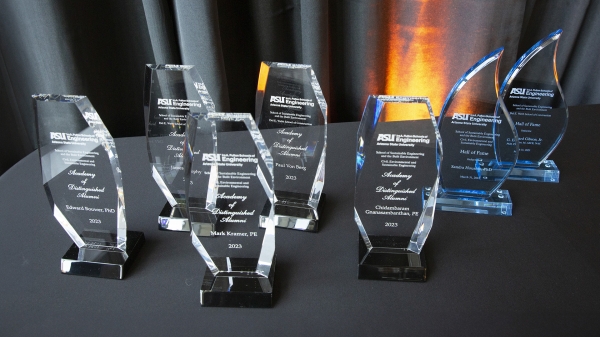New research by an Arizona State University professor shows that when companies say, “We’re sorry,” it doesn’t always make them look better, at least in the short term.
A recent paper by Jonathan Bundy, an associate professor of management in the W. P. Carey School of Business, looked at how companies responded after two kinds of crises and then how that response affected their reputations.
“Companies have multiple reputations. They’re known for a bunch of different things,” he said.
“When you think about a crisis or negative event, the actions you take to defend yourself may be positive in protecting one reputation and negative in helping another reputation. There’s an idea of conflict.”
The concept of companies having multiple reputations is pretty new, Bundy said.
“On the researcher side and also the practitioner side, we’ve been looking at it coarse-grained until this point, thinking of firms as having one reputation, and thinking about the way they respond to crises or negative events that’s universal to how people react.
“This paper tries to unpack that and say, ‘An apology does work, but it’s somewhat limited in which cases it works.’"
In the research paper, published in the June issue of Strategic Management Journal, Bundy and the other researchers The co-author were Farhan Iqbal and Michael D Pfarrer, both of the Terry College of Business, University of Georgia.cover two kinds of reputation: capability and character.
“Capability reputation is about whether the firm makes a good product or provides a good service,” he said.
“Character reputation is about integrity. Does it do good things in terms of corporate social responsibility? Does it take care of its stakeholders?”

Jonathan Bundy
The paper, titled "Reputations in Flux: How a firm defends its multiple reputations in response to different violations," sampled 241 cases of companies that had an unintentional accounting error, a capability violation, and 74 cases of companies that faced a fine of $50,000 or more by the Environmental Protection Agency, a character violation.
“To my chagrin as a person, we find that apologies don’t work and are sometimes harmful, given the nature of the event or crisis.
“It’s really complicating how we understand reputation management in today’s age.”
Bundy answered some questions from ASU News:
Question: How many reputations can a firm have?
Answer: When I teach about reputations, I like to say they are infinite. It’s in the mind of every single stakeholder you interact with. I may view Apple as positive along certain dimensions. Apple product designs are appealing. I think they work. But maybe I don’t like the way they treat employees or their contractors in China, or whatever it might be.
It’s difficult to study all of those and as a manager, it’s difficult to manage all of those.
Capability reputation and character reputation are managed in different ways.
The only time we see an apology work is when a firm’s ability reputation is threatened in a crisis. So when a firm does something that signals that its products or services aren’t as good as we thought, an apology sends a signal that they’re accountable and fixing the problem.
But in every other case, we find that apology doesn’t work as well.
That’s interesting, because if we look at how firms defend themselves, the first thing would be an apology and taking responsibility and being proactive, and what we show is that being proactive can be negative.
Q: How did you measure reputation?
A: We measured reputation by how firms were talked about in the media. We downloaded a bunch of articles from the top 50 newspapers in the country and we used content analysis, a computer program that combs through the articles and tries to figure out how the firm is talked about. We developed a custom dictionary and were able to say, “These words and this kind of framing signals a positive capability reputation and these other words signal a positive character reputation.”
And then we looked at how, after a crisis, a response is triggered, measured via what is said in the media and in press releases. We hand-coded them for whether they contained an apology or an excuse or a denial, things like that.
We looked at how the response influenced how the firm was talked about in the media in the immediate seven days after.
Q: Why would an apology make things worse?
A: If you caught me cheating, stealing or whatever, there’s a lot of research that shows that if I apologize and take responsibility, you react worse than if I deny or make an excuse. The reason is because the apology admits guilt.
We’ve applied this to the organizational level.
If I apologize, I just admitted that I lacked integrity and you’re more inclined to not trust me down the road, even though I’m taking responsibility. There’s a conflict there.
I’ve been thinking a lot about the “now what?” The task for managers is you have this negative moral sign that you violated integrity, and in our case we measured that with EPA violations — you trashed the environment. You want to take responsibility because you think it’s the right thing to do, but in doing so, people don’t trust you as much.
There’s a delicate balance that managers need to find.
Q: So what should companies do?
A: It’s a combination of what you say and what you do. Not only do you need to apologize, you also need to take a lot of corrective actions to show that you’re a different company after the crisis.
If it’s just an apology — “We messed up” — people won’t be inclined to trust you because you haven’t done anything redemptive. The words need to be matched with deeds.
We’re seeing that a lot in the era of social justice. A lot of folks are saying, “It’s not enough to say you support an effort. You have to walk the talk.”
We only looked at what the firms said. We showed that talk in the immediate aftermath is bad.
But I suspect positive talk combined with positive action in the long term is a useful strategy.
From a normative viewpoint, it’s still valuable to take responsibility by apologizing. I think it’s the right thing to do, when I put my ethics hat on. But showing that firms that are doing it are being punished means I think there’s a dynamic element to it.
Q: Do firms have to apologize to recover from a crisis?
A: We didn’t look at long-term reactions, and I suspect that taking a short-term hit to reputation with the denial strategies may have bigger long-term consequences.
For example, I teach about Nike. In the 1980s and '90s, Nike was accused of using sweatshop labor. Its first response was to deny and deflect. They blamed their suppliers.
In the longer term, the narrative shifted. They said, “We should take more responsibility for what our suppliers are doing and what our supply chain looks like.”
Fast forward to today and they’re hailed as a champion for this issue and they get a lot of very good will from it.
In contrast, look at BP, which had the big oil spill. They kind of denied and deflected, and while their actions did a lot to stop it, down the road they’ve continued to deny and deflect. Long term, it’s having an effect on their reputation. They’re not seen as a hero of the environment because they didn’t take responsibility.
Nike showed that taking action to address the issue can be a powerful redemptive tool.
Wells Fargo had a big crisis and they kind of followed the Nike playbook in initially denying and deflecting blame. Then they came around and fired the CEO and said, “We had a bad system in place and now we’re trying to fix it.” I think maybe there’s a long-term possibility for Wells Fargo to redeem itself and say, “We care about our customers.”
What this might suggest in terms of reputation management is that the first six to seven days, there’s an important task in stopping stakeholders’ gut reactions to be negative against you. Companies might, in addition to an apology, say, “We’re trying to figure out what happened. We’re trying to get to the bottom of it.”
I think future research needs to figure out the best way to do this.
It’s a lot harder to study long term because it gets so messy. In the first six days, a lot of firms’ communications are about the event. As you go to a week, a month, a year, there’s so much other stuff that influences reputation that gets injected, so it’s hard to do on a large scale. That’s why we use case studies like Nike and BP.
Q: What is the effect of social media?
A: In this study, our sample ends in 2009, so social media wasn’t a thing.
I think what the age of social media tells us is it’s not the first week, it’s the first hour. As the Twitter outrage begins, firms are more and more pressed to say something, and I think their gut response is to provide an apology. But more and more, when firms do that, it doesn’t stop the Twitter outrage. It adds fuel to the fire.
What I would suggest is that if you’re going to provide an apology, you have to quantify that with efforts at change. You can’t say, “We’ll do better.” It might be, “We’re sorry and here are three specific things we will do to ensure that this doesn’t happen again.” Nike, after the fact, did that. Wells Fargo, after the fact, did that. BP did not do that.
Q: So should companies instead deny that they did something wrong?
A: I’ve long struggled with the implications of this paper. I don’t want to say firms should be defensive, even though I empirically show they should. Part of me is not convinced that as a long-term strategy, it’s effective.
I find the results depressing because it shows, as a society, that we say we want apologies and for firms to take responsibility, but when they do, we punish them. It’s this idea that if we punish people for doing the right thing and taking responsibility and apologizing, it will incentivize them to not do those things.
It’s on us as a society and to check our guts and to say, “Hey, they apologized and to give them credit for taking responsibility.”
If our reaction is, “We can’t trust them anymore,” it will encourage companies to say, “It’s someone else’s fault.”
The takeaway is that it’s complicated.
Top image of an oil rig courtesy of Pixabay.com.
More Business and entrepreneurship

Thunderbird at ASU, W. P. Carey School team up on concurrent master's degrees
Students are now able to take advantage of two world-class schools at Arizona State University, at the same time. The Thunderbird School of Global Management and W. P. Carey School of Business…

ASU alum's personalized greeting card kiosk debuts on Tempe campus
Everyone knows how disheartening it is to dash into a store to grab a last-minute holiday card and find the selection picked over and in disarray.An Arizona State University alumna has created a…

Celebrating industry giants and distinguished alumni
Four outstanding alumni and two industry leaders will be honored at the School of Sustainable Engineering and the Built Environment’s Hall of Fame and Academy of Distinguished Alumni event, scheduled…
